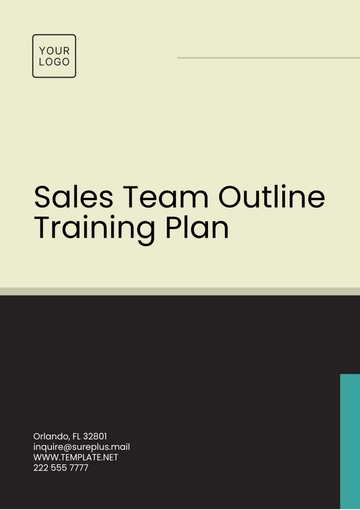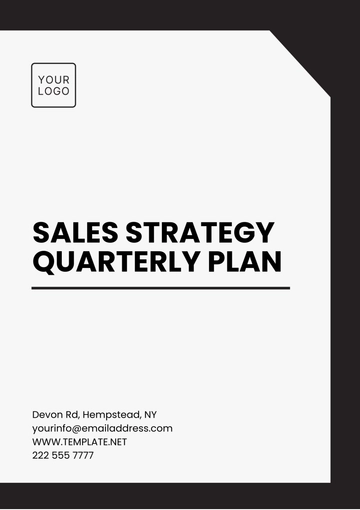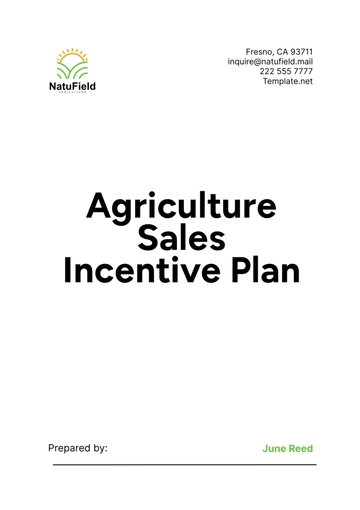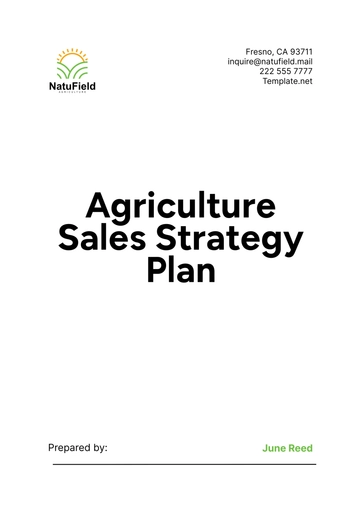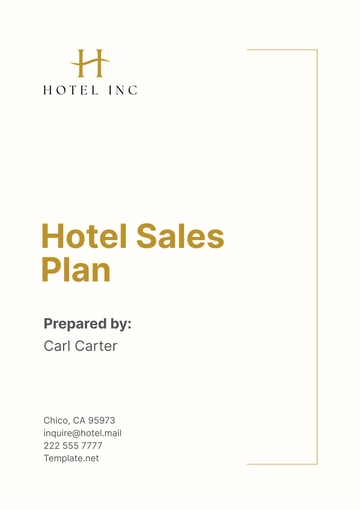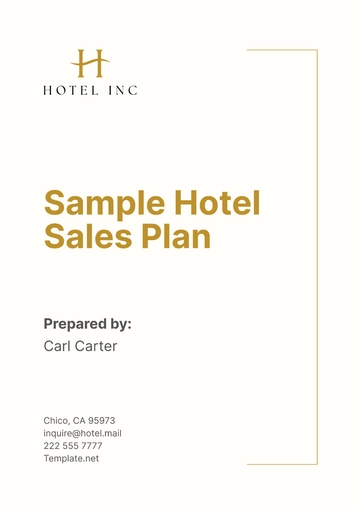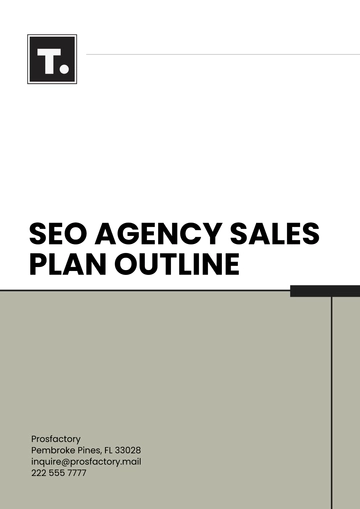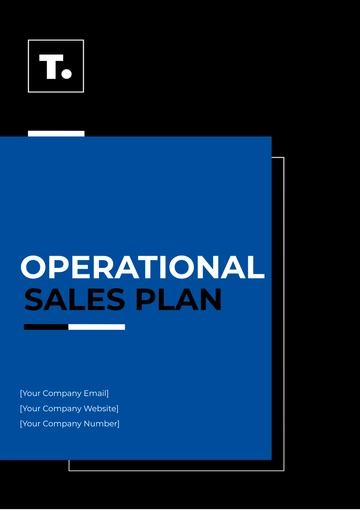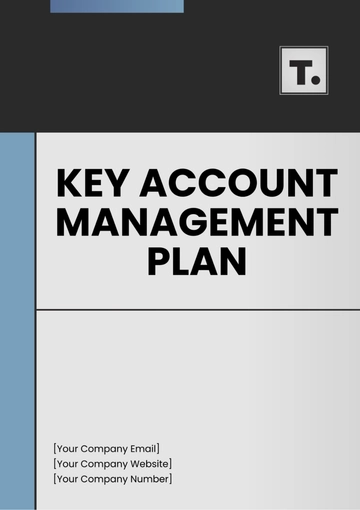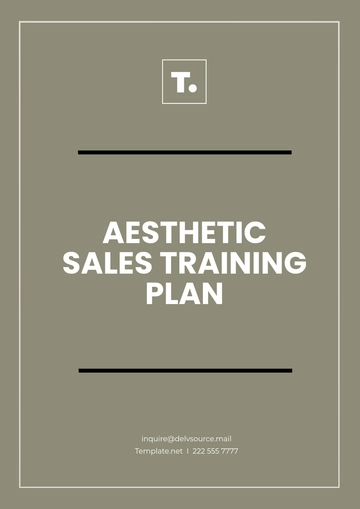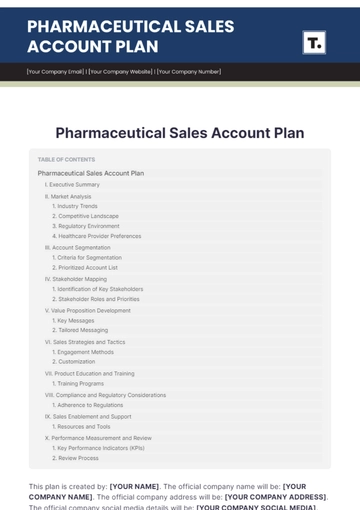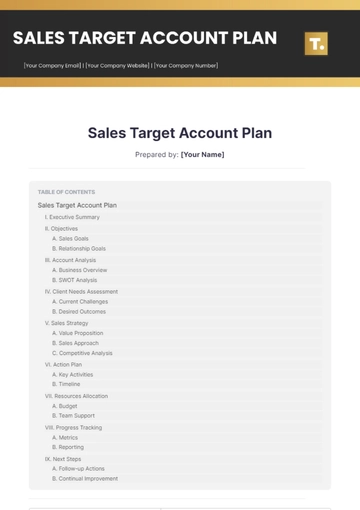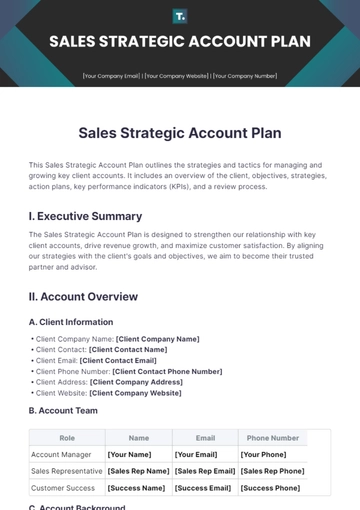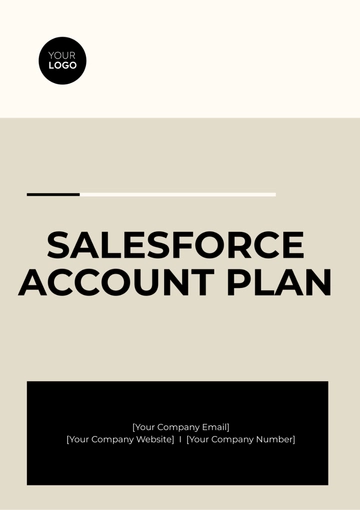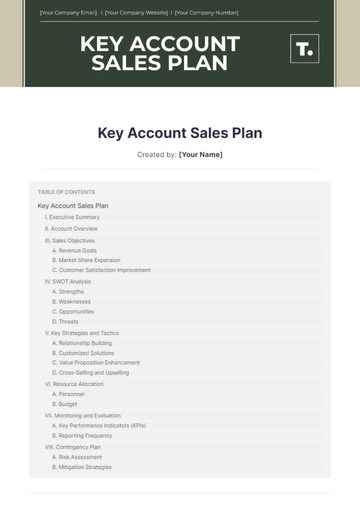Free Quarterly Sales Plan

TABLE OF CONTENTS
I. Executive Summary
II. Introduction
A. Purpose
B. Navigating Market Dynamics
C. Building on a Strong Foundation
D. The Road Ahead
III. Market Analysis
A. Market Trends
B. Competitor Analysis
IV. Sales Goals and Objectives
A. Goals
B. Objectives
V. Sales Strategies
A. Customer Segmentation
B. Product Focus
C. Pricing Strategy
VI. Sales Tactics
A. Sales Training
B. Lead Generation
C. Sales Pipeline Management
VII. Sales Team and Resources
A. Team Expansion
B. Technology and Tools
C. Performance Metrics
VIII. Revenue Forecast
A. Sales Projections
B. Risk Assessment
IX. Risk Analysis
A. Mitigation Strategies
X. Conclusion
I. Executive Summary
In Q1 [Year], our sales team will embark on an ambitious journey to drive revenue growth, enhance customer satisfaction, and solidify our position as a market leader. This Quarterly Sales Plan outlines our strategy, goals, and tactics to achieve our sales targets in a dynamic and competitive market.
II. Introduction
A. Purpose
The purpose of this Quarterly Sales Plan for Q1 [Year] is to provide a comprehensive roadmap for our sales team. It serves as a strategic guide that articulates our approach to achieving our revenue targets and customer satisfaction goals. We recognize that the technology industry is not only competitive but also evolving at an unprecedented pace. Therefore, this plan is designed to equip our sales team with the tools and insights they need to succeed in this dynamic environment.
B. Navigating Market Dynamics
In the fast-paced world of [Year], understanding market dynamics is paramount. Our focus on market segmentation, product innovation, and customer-centric pricing stems from a deep understanding of the ever-shifting needs and expectations of our clients. By aligning our strategies with market trends, we aim to remain agile and responsive to evolving customer demands.
C. Building on a Strong Foundation
Our journey in Q1 [Year] builds upon the success and lessons learned from previous quarters and years. It's a testament to the unwavering commitment and dedication of our sales team. While we have set ambitious goals, they are rooted in the knowledge that we have the expertise, the products, and the determination to achieve them.
D. The Road Ahead
The road ahead is one of challenges and opportunities. It's a journey that involves continuous learning, adaptability, and innovation. As the Sales Operations Manager, I am committed to providing the leadership and resources needed to empower our sales team and ensure that our customers receive not just the best products but the best service as well.
In the pages that follow, we will delve deeper into our market analysis, sales goals, strategies, tactics, and resources. Together, we will chart a course towards our Q1 [Year] objectives, keeping in mind that this plan is not static but a dynamic framework that will evolve as we progress, learning and growing with each step.
III. Market Analysis
A. Market Trends
The technology industry in [Year] continues to undergo rapid transformation. Innovations in areas such as artificial intelligence, quantum computing, and green technology are driving change. Consumers and businesses alike are demanding products and services that are not only cutting-edge but also environmentally sustainable. As a result, we need to prioritize the development of eco-friendly and AI-driven solutions.
In this quarter, we'll closely monitor emerging trends and adapt our product offerings and sales strategies to capitalize on them. By aligning our product portfolio with market demands, we aim to gain a competitive edge and meet the needs of our customers.
B. Competitor Analysis
In this highly competitive landscape, our key rivals include [Competitor Company Name 1] and [Competitor Company Name 2]. To develop effective strategies and tactics, it's essential to perform a comprehensive analysis of our competitors' strengths, weaknesses, opportunities, and threats (SWOT).
[Competitor Company Name 1]:
Their strength lies in product innovation and a solid customer base, but they have been slow to adopt sustainable practices. We can leverage this by emphasizing our sustainability efforts.
[Competitor Company Name 2]:
They excel in customer support and have been investing heavily in AI technologies. To compete effectively, we will prioritize enhancing our customer support and promoting the AI features of our products.
By understanding our competitors' positions, we can refine our strategies to take advantage of gaps and opportunities in the market.
IV. Sales Goals and Objectives
A. Goals
Achieve a Q1 revenue target of $50 million: The revenue target represents a 15% growth from the previous quarter. It's an ambitious goal but reflects our confidence in our products and team.
Expand our customer base by 20%: This growth is necessary for long-term sustainability. It includes gaining new customers while retaining and upselling to existing ones.
Improve customer satisfaction scores by 15%: Ensuring our customers are happy is crucial for retention and building a positive reputation in the market.
B. Objectives
Increase sales team productivity by 10%: We aim to improve productivity through training, technology, and streamlined processes.
Launch two new products: To excite our customer base and attract new clients, we will introduce innovative products in the sustainable and AI-powered categories.
Enhance after-sales support: Ensuring that our customers receive exceptional post-sale support is key to long-term relationships. We will focus on reducing response times and addressing issues effectively.
V. Sales Strategies
A. Customer Segmentation
Segmenting our customers into three categories—enterprise, mid-sized businesses, and small businesses—will allow us to tailor our strategies to their specific needs. For enterprise customers, we will focus on providing customized, high-value solutions. Mid-sized businesses will benefit from a balance of features and affordability, while small businesses will have access to cost-effective, scalable solutions.
B. Product Focus
Our primary product focus will revolve around sustainable and AI-powered solutions. Sustainable products are in high demand due to growing environmental awareness. These products will be promoted not just for their eco-friendliness but also for their superior performance and cost-efficiency. Simultaneously, we will emphasize the AI capabilities of our products, highlighting how they improve efficiency and productivity.
C. Pricing Strategy
To capture maximum value from our products, we will implement a value-based pricing strategy. Large enterprises will receive personalized pricing based on their specific needs and budget constraints. By aligning our pricing with the perceived value of our solutions, we aim to improve our profit margins while offering competitive rates to our clients.
VI. Sales Tactics
A. Sales Training
Sales training is a priority for our team's success. Bi-weekly training sessions will cover a range of topics, including deep product knowledge, objection handling, and negotiation skills. By empowering our salesforce with the right knowledge and skills, we expect them to excel in their interactions with customers.
B. Lead Generation
Our lead generation strategy involves a mix of digital marketing, targeted email campaigns, and participation in industry events and trade shows. We will also explore strategic partnerships to tap into existing customer networks.
C. Sales Pipeline Management
We will implement a robust Customer Relationship Management (CRM) system to track leads and sales opportunities. Defining clear sales stages and key performance indicators (KPIs) will enable us to monitor and manage the sales pipeline effectively. This data-driven approach will improve forecasting and allow for informed decision-making.
VII. Sales Team and Resources
A. Team Expansion
Expanding our sales team is essential to meet our growth objectives. We plan to hire five new sales representatives to increase our market coverage and bring in fresh talent. Additionally, a dedicated sales trainer will help keep our team updated on the latest sales techniques and product knowledge.
B. Technology and Tools
To support the sales team, we will invest in advanced analytics tools to provide insights into customer behavior and market trends. Equipping our team with laptops and smartphones for remote working ensures they can engage with customers anytime, anywhere.
C. Performance Metrics
We will set individual and team KPIs, including revenue targets, customer satisfaction scores, and lead conversion rates. Regular performance reviews and coaching sessions will allow us to continually improve the skills and performance of our sales team.
VIII. Revenue Forecast
A. Sales Projections
Our revenue projections for Q1 2050 are as follows:
Month 1: $12 million: This represents a solid start to the quarter.
Month 2: $16 million: We expect revenue to grow as our new product launches gain traction.
Month 3: $22 million: By the end of the quarter, we anticipate an accelerated revenue growth due to our effective strategies and tactics.
B. Risk Assessment
In assessing the risks associated with our revenue forecast, we've identified several potential challenges:
Economic downturn:
Global economic conditions are unpredictable. To mitigate this risk, we will maintain a flexible budget and contingency plans.
Supply chain disruptions:
The ongoing importance of international supply chains presents a risk. We will diversify our suppliers and maintain a safety stock to minimize the impact of any disruptions.
Competitive threats:
Rivals such as [Competitor Company Name 1] and [Competitor Company Name 2] pose ongoing competition. To counter this, we will continuously monitor their activities and adapt our strategies accordingly.
IX. Risk Analysis
A. Mitigation Strategies
Diversify suppliers and maintain a safety stock: By working with multiple suppliers and holding a reserve inventory, we can minimize the impact of supply chain disruptions.
Monitor economic indicators:
We will establish a dedicated team to track global economic indicators and act swiftly in response to any signs of a downturn.
Continuously assess competitor moves:
Regular competitive analysis will help us identify and respond to changes in our competitors' strategies, allowing us to maintain a competitive advantage.
X. Conclusion
The Q1 [Year] Quarterly Sales Plan is a comprehensive roadmap that addresses the dynamic and competitive market landscape. By staying attuned to market trends, understanding our competitors, and focusing on customer-centric strategies, we are confident in our ability to achieve our revenue targets and maintain our position as a market leader.
The plan emphasizes the importance of aligning our sales strategies with the evolving needs of our customers, while also investing in our sales team's capabilities and resources. This holistic approach, coupled with an agile response to potential risks, will be pivotal in our success during this quarter and beyond.
- 100% Customizable, free editor
- Access 1 Million+ Templates, photo’s & graphics
- Download or share as a template
- Click and replace photos, graphics, text, backgrounds
- Resize, crop, AI write & more
- Access advanced editor
Plan your quarterly sales strategy with Template.net's editable Quarterly Sales Plan Template. Designed to be highly customizable, this template can be easily edited in our Ai Editor Tool for maximum convenience. The strategic framework aims for excellence and ensures your marketing efforts hit the right mark. Don't let structure limit your creativity; instead, allow our template to bring out the best in your marketing acumen.
You may also like
- Finance Plan
- Construction Plan
- Sales Plan
- Development Plan
- Career Plan
- Budget Plan
- HR Plan
- Education Plan
- Transition Plan
- Work Plan
- Training Plan
- Communication Plan
- Operation Plan
- Health And Safety Plan
- Strategy Plan
- Professional Development Plan
- Advertising Plan
- Risk Management Plan
- Restaurant Plan
- School Plan
- Nursing Home Patient Care Plan
- Nursing Care Plan
- Plan Event
- Startup Plan
- Social Media Plan
- Staffing Plan
- Annual Plan
- Content Plan
- Payment Plan
- Implementation Plan
- Hotel Plan
- Workout Plan
- Accounting Plan
- Campaign Plan
- Essay Plan
- 30 60 90 Day Plan
- Research Plan
- Recruitment Plan
- 90 Day Plan
- Quarterly Plan
- Emergency Plan
- 5 Year Plan
- Gym Plan
- Personal Plan
- IT and Software Plan
- Treatment Plan
- Real Estate Plan
- Law Firm Plan
- Healthcare Plan
- Improvement Plan
- Media Plan
- 5 Year Business Plan
- Learning Plan
- Marketing Campaign Plan
- Travel Agency Plan
- Cleaning Services Plan
- Interior Design Plan
- Performance Plan
- PR Plan
- Birth Plan
- Life Plan
- SEO Plan
- Disaster Recovery Plan
- Continuity Plan
- Launch Plan
- Legal Plan
- Behavior Plan
- Performance Improvement Plan
- Salon Plan
- Security Plan
- Security Management Plan
- Employee Development Plan
- Quality Plan
- Service Improvement Plan
- Growth Plan
- Incident Response Plan
- Basketball Plan
- Emergency Action Plan
- Product Launch Plan
- Spa Plan
- Employee Training Plan
- Data Analysis Plan
- Employee Action Plan
- Territory Plan
- Audit Plan
- Classroom Plan
- Activity Plan
- Parenting Plan
- Care Plan
- Project Execution Plan
- Exercise Plan
- Internship Plan
- Software Development Plan
- Continuous Improvement Plan
- Leave Plan
- 90 Day Sales Plan
- Advertising Agency Plan
- Employee Transition Plan
- Smart Action Plan
- Workplace Safety Plan
- Behavior Change Plan
- Contingency Plan
- Continuity of Operations Plan
- Health Plan
- Quality Control Plan
- Self Plan
- Sports Development Plan
- Change Management Plan
- Ecommerce Plan
- Personal Financial Plan
- Process Improvement Plan
- 30-60-90 Day Sales Plan
- Crisis Management Plan
- Engagement Plan
- Execution Plan
- Pandemic Plan
- Quality Assurance Plan
- Service Continuity Plan
- Agile Project Plan
- Fundraising Plan
- Job Transition Plan
- Asset Maintenance Plan
- Maintenance Plan
- Software Test Plan
- Staff Training and Development Plan
- 3 Year Plan
- Brand Activation Plan
- Release Plan
- Resource Plan
- Risk Mitigation Plan
- Teacher Plan
- 30 60 90 Day Plan for New Manager
- Food Safety Plan
- Food Truck Plan
- Hiring Plan
- Quality Management Plan
- Wellness Plan
- Behavior Intervention Plan
- Bonus Plan
- Investment Plan
- Maternity Leave Plan
- Pandemic Response Plan
- Succession Planning
- Coaching Plan
- Configuration Management Plan
- Remote Work Plan
- Self Care Plan
- Teaching Plan
- 100-Day Plan
- HACCP Plan
- Student Plan
- Sustainability Plan
- 30 60 90 Day Plan for Interview
- Access Plan
- Site Specific Safety Plan



